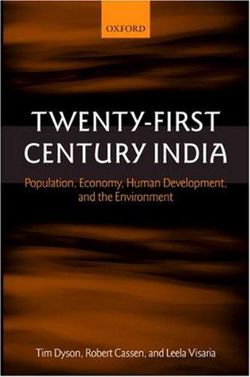Twenty-First Century India is the first study of India's development giving a fully integrated account of population and development. It is built on new projections of the population for fifty years from the Census of 2001. India's population then had already passed 1 billion. Twenty-five years later it will exceed 1.4 billion, and will almost certainly pass 1.5 billion by mid-century. The projections incorporate for the first time both inter-state migration and the
role of HIV/AIDS. They also show India's urban future, with close to half a billion urban inhabitants by the year 2026. The implications of this population growth are then traced
out in a range of modelling and analytical work. Growing numbers are found to complicate the task of achieving widespread education in a number of India's states, while other states are already experiencing declines in their school-age population. Demographic growth also contributes to poverty, and increasing divergence in social conditions among the states. As population growth slows in the country overall, the labour force continues to grow relatively fast, with difficult consequences for
employment. But national economic growth could be accelerated by the 'demographic bonus' of the declining proportion of dependents to workers in the population. The book is
reasonably optimistic about India's food prospects: the country can continue to feed itself. It can also enjoy higher levels of energy use, manufacturing, and modern forms of transport, while experiencing less chemical pollution. India's cities can become cleaner and healthier places to live. Perhaps the most difficult environmental issue, and the one most strongly related to population growth, is water. Some states also face severe pressures on common property resources. A policy chapter
concludes the book. India's future problems are large, but in principle manageable. However, whether the country will actually achieve sustainable development for all is another matter.
- ISBN:
- 9780199283828
- 9780199283828
-
Category:
- Development economics & emerging economies
- Format:
- Paperback
- Publication Date:
-
05-05-2005
- Language:
- English
- Publisher:
- Oxford University Press
- Country of origin:
- United Kingdom
- Pages:
- 440
- Dimensions (mm):
- 233x156x24mm
- Weight:
- 0kg
This title is in stock with our Australian supplier and should arrive at our Sydney warehouse within 2 - 3 weeks of you placing an order.
Once received into our warehouse we will despatch it to you with a Shipping Notification which includes online tracking.
Please check the estimated delivery times below for your region, for after your order is despatched from our warehouse:
ACT Metro 2 working days
NSW Metro 2 working days
NSW Rural 2 - 3 working days
NSW Remote 2 - 5 working days
NT Metro 3 - 6 working days
NT Remote 4 - 10 working days
QLD Metro 2 - 4 working days
QLD Rural 2 - 5 working days
QLD Remote 2 - 7 working days
SA Metro 2 - 5 working days
SA Rural 3 - 6 working days
SA Remote 3 - 7 working days
TAS Metro 3 - 6 working days
TAS Rural 3 - 6 working days
VIC Metro 2 - 3 working days
VIC Rural 2 - 4 working days
VIC Remote 2 - 5 working days
WA Metro 3 - 6 working days
WA Rural 4 - 8 working days
WA Remote 4 - 12 working days




Share This Book: